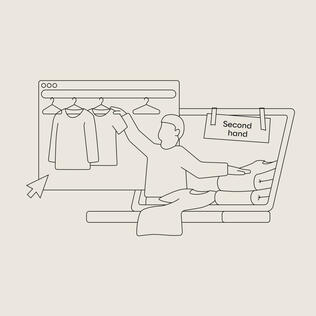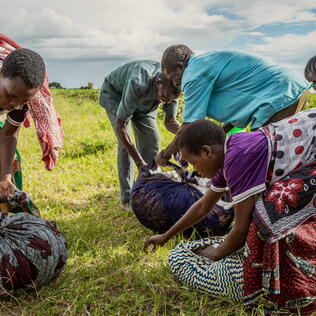training sessions being held
Chemical handling: Staying clean!

Chemicals are part of manufacturing textiles. They are used in dyeing, make yarn more durable or fabrics water-repellent. Yet many of them have an adverse impact on the environment. That is why the Otto Group has been working for years to reduce this impact.
Cooperations
The supply chain for textile manufacturing is complex and not easy to monitor. One reason for this is because we as a retail company do not have our own factories. In addition to our own brands, we also sell products from business partners to whose facilities we do not have direct access and where other brands and retailers manufacture clothing as well. On its own, the Otto Group would have great difficulty initiating and implementing measures to make changes in the handling of chemicals, primarily in wet processes (dyeing, washing, printing), in the deeper supply chain. Collaborating with our business partners, other market participants, and the producers or factories themselves is therefore extremely important. For this reason, we are engaging in several initiatives that operate across company boundaries, such as the German government's Alliance for Sustainable Textiles and are guided by industry standards such as the ZDHC (Zero Discharge of Hazardous Chemicals). These initiatives have set themselves the task of cooperating to improve working conditions along the supply chain and chemical management in factories in order to reduce environmental impact. To this end, the Otto Group has developed a multilayered approach, which is intended to provide greater transparency and more improvement along the supply chain.
Guidelines
Transparency plays an extremely important role in our chemical management. We rely on our business partners disclosing which factories they work together with and to what extent chemicals are used along the supply chain. With the aid of guidelines and handbooks, we provide the business partners and factories with direction and support to help them improve their chemical management. The following points are important to our approach:
- We have developed a handbook for chemical management. It introduces the most important topics of the production process and contains practical advice on how a factory handles chemicals responsibly. The handbook (like all other documents) is written in the language of the respective location and is to be understood as instructions that are to be continuously improved upon and that are intended to meet the requirements of the Otto Group and other business.
- We use the Manufacturing Restricted Substances List (MRSL) of the ZDHC Foundation. It is the industry standard. The MRSL defines limit values for selected chemicals in textile production and provides instructions on which to avoid and which need to be replaced in production.
- The platform we use is The BHive, which makes a digital chemical inventory possible. Using an app, factories can simply check whether the chemicals used meet the requirements and are harmless. This way, we obtain greater transparency regarding the chemicals used in production and can initiate the targeted measures.
- Our own internal guidelines (Restricted Substances List) define chemicals that are prohibited in the end-product – either completely or above a set limit value.
- We explain the potential hazards of PFCs to our business partners in an informational brochure. These perfluorinated and polyfluorinated chemicals repel water, fat, and dirt and are used in many consumer products. They are not unharmful, however, as they are almost fully non-degradable and can be hazardous to humans. In the brochure, we list suitable PFC alternatives for factories and show how they can be replaced.
Knowledge transfer
Through the EMPact program, we enter into dialog with our business partners and the factories along the supply chain. The program is designed to help the factory management and the employees handle chemicals more consciously and maintain the necessary safety standards. In addition to the above-mentioned handbooks and documents as a basis for a sustainable chemical management, we also offer training programs on site. Along with our subsidiary Systain Consulting GmbH, we developed an individual training program back in 2016 as part of a public private partnership and have been holding it each year ever since. The program was designed in close collaboration with 44 of our most important suppliers from China, Bangladesh, and Turkey as well as with experts from science and civil engineering. It combines training over several days on relevant topics (such as basic knowledge about chemicals, safe storage, safe handling, waste management, and wastewater treatment) with on-site visits by experts. At first, the focus is on forming an awareness of the effects of insufficient chemical management. Next, gaps in knowledge of meaningful improvement measures are filled in, and the specific local conditions are taken into account. It is precisely by our striving to lead dialogs on an equal footing that we achieve sustainable improvements through EMPact. With additional training options within the context of the Alliance for Sustainable Textiles and in collaboration with other companies, we also offer even more intensive training over a total of ten months and provide targeted assistance to factories in the replacement of dangerous chemicals.
Successes
Between 2016 and 2021, we were able to reach a great many people with our training sessions. During this time frame, chemical management improved in the participating factories by 28 percent.
The Training Sessions in Numbers

participants
countries
participating factories
We see that the factories are implementing the knowledge learned and are continuing to develop it further on their own even after the training – proof of the long-term effectiveness of this capacity-building approach.
As part of EMPact, our subsidiary Systain Consulting has also identified advances and continuing problems in the factories in various case studies. The experts at Systain visit operations in China, Pakistan, or India twice a year, where they evaluate how chemicals are handled, stored, used, and disposed of and offer advice on how things should be changed. The main focus is on occupational safety and environmental protection. For example, the protective clothing for workers was improved in most cases, warehousing was made safer and more manageable, and wastewater management became more sustainable. In one plant in Karachi, Pakistan, the operator built a treatment plant where water from the dyeing process was cleaned and further processed. Before that, the handling of it at this site was inadequate. With the help of EMPact, many participating factories have substantially raised their chemical management to a higher level.
Innovation
The dyeing of textiles requires water. A lot of water. It is said that between six and nine billion liters are needed across the entire textile industry. And yet clothes can be dyed a new color without water with the DyeCoo procedure, a method developed in the Netherlands that uses liquid CO2 to apply color. This dyeing process does not require a single drop of water or any process chemicals – and 95 percent of the CO2 can be reused. Bonprix supports this new, water-free method and has established the CleanDye joint venture with partners. Working together, they have opened up a dye factory in Vietnam, which exclusively operates using the DyeCoo procedure. This example illustrates that there is always the possibility of new, sustainable ways besides the old familiar ones. All that is needed is the courage to embark upon them.





